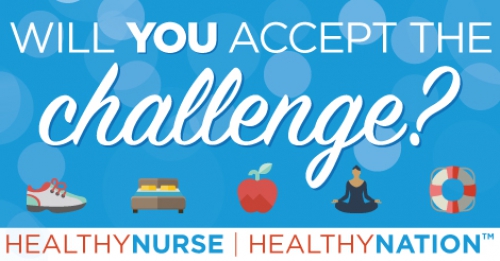Call to Action for Nurses to Prioritize Sleep
Published
By Susan H. Weaver
A nurse, who had been working the night shift for about one year, was driving home after working nights and being awake for 24 hours. She felt she was fine to make the 20-minute drive home. As she neared her home, she woke up when she heard a loud crash and felt the air bag deploy. She had fallen asleep, passed out at the wheel. She smashed into a parked car, with the driver inside, and totaled her car. Thankfully, both she and the other driver were not injured.
After working two consecutive night shifts, another new graduate nurse suddenly felt dizzy driving home which led to her car hitting a road sign and veering into oncoming traffic. This close call made her realize the serious dangers of drowsy driving. She also recognizes that many believe it won’t happen to them and feels strongly that education on recognizing fatigue and preventing drowsy driving is essential for those new to the night shift.
 Unfortunately, drowsy driving-related accidents and even tragic outcomes are not uncommon among nurses, particularly those working the night shift. Fatigue and reduced alertness negatively impact nurses' job performance but also compromise their physical and mental health, safety, and well-being. Despite the American Nurses Association (ANA) 2014 position statement “Addressing Nurse Fatigue to Promote Safety and Health” and the American Academy of Nursing 2017 position statement “Reducing fatigue associated with sleep deficiency and work hours in nursing” highlighting healthcare worker fatigue, many nurses are unaware of the risks and consequences of fatigue and inadequate rest (ANA, 2014; Caruso et al., 2017).
Unfortunately, drowsy driving-related accidents and even tragic outcomes are not uncommon among nurses, particularly those working the night shift. Fatigue and reduced alertness negatively impact nurses' job performance but also compromise their physical and mental health, safety, and well-being. Despite the American Nurses Association (ANA) 2014 position statement “Addressing Nurse Fatigue to Promote Safety and Health” and the American Academy of Nursing 2017 position statement “Reducing fatigue associated with sleep deficiency and work hours in nursing” highlighting healthcare worker fatigue, many nurses are unaware of the risks and consequences of fatigue and inadequate rest (ANA, 2014; Caruso et al., 2017).In the Fall of 2022, a study was conducted to examine the difference in fatigue and sleep quality between day and night shift clinical nurses and the consequences of fatigue. There was a statistically significant difference between clinical nurses working day and night shift, for the total score of the Pittsburgh Sleep Quality Index (PSQI) as well as all of its subscales, and all subscales of the Occupational Fatigue Exhaustion Recovery (OFER) scale. Night shift nurses reported the poorest patterns and quality of sleep and had greater acute and chronic fatigue than those on the day shift. However, the global sleep quality score was >5 for both day and night shift clinical nurses indicating poor sleep quality. Although both day and night shift nurses had poor sleep quality, nurses on day shift had higher scores in intershift recovery, meaning they are better able to recover from work-related fatigue by the next work shift. The Brief Fatigue Index (BFI) also showed a significant difference between the two groups in all subscales, with night nurses experiencing greater fatigue and interference with daily activities than nurses working day shift (Weaver et al., 2024).
This study also found that more night shift than day shift nurses recalled a fatigue-related error, falling asleep at a red light, missing their exit, and having a car accident or near miss when driving home compared to day shift nurses (Weaver et al., 2024). The commute home after night shifts can be difficult due to the interaction of sleep pressure from working all night and the strong circadian drive for sleep. Microsleeps, brief episodes of involuntary sleep lasting up to 15 seconds, further impair driving abilities. Nurses have reported “falling asleep at red lights” and “waking up at the light when the person behind me had to get out of his car to bang on my window” to “horns honking that woke me up at the light” (Vitale et al., 2015, p.75).
As nurses, it is our ethical responsibility to practice healthy behaviors, prioritize our sleep, and arrive to work alert and well-rested in order to provide optimal patient care. For nurses, particularly those working night shift contrary to their circadian rhythms, there are evidenced-based strategies to foster sleep and mitigate their fatigue.
- Prioritize Sleep. Seven or more hours of sleep are needed. Nurses need to arrange their family and personal obligations around their sleep, and not sacrifice their sleep to accommodate these obligations.
- Create a conducive sleep environment. Your room should be dark, quiet, and cool, aided by blackout curtains, eye masks, headphones, and white noise.
- Establish healthy nutritional and exercise regimen. For nurses working night shift, eat small healthy meals such as fruits, vegetables, protein, and salads. A small breakfast before going to sleep helps prevent hunger-related waking.
- Keep hydrated. Staying hydrated boosts alertness and reduces fatigue. Avoid caffeine seven hours before sleep.
- Take breaks. Adopt a break-taking culture and take scheduled breaks in designated break areas during your shift.
- Prevent drowsy driving. Adopt strategies for a safe drive home such as increasing the volume of the radio, eating healthy snack, having phone conversations with friends, or having a few sips of coffee just before leaving work.
Once a year, night shift nurses work an extra hour due to the time change, which many nurses consider the worst night of the year. The end of that shift is particularly disheartening due to heightened fatigue along with day shift staff arriving feeling refreshed, benefiting from an additional hour of sleep. Many organizations celebrate and recognize those who work the night shift by hosting a “Fall Back” Celebration on that night, which this year will be November 3, 2024. This date is also a good opportunity to remind night shift nurses about the risks of fatigue and drowsy driving, as it coincides with the start of the National Sleep Foundation’s Drowsy Driving Prevention week on November 3, 2024. Night shift nurses are at greater risk due to disrupted circadian rhythms and the challenge of working opposite of the typical daytime routine of society. Fatigue from night shifts can impair reaction time similar to driving under the influence. This week is an opportunity to raise awareness and promote solutions to help nurses prioritize sleep and drive home safely.
Resources
Elmowitz, D., Spirito, T., Alves, L., Savastano, C., Sepulveda, D. M., Hopkins, M, & Wertz, B. (2023). Tips for thriving–not just surviving–on the night shift. American Nurse Journal, 18(9), 55-61. https://www.myamericannurse.com/tips-for-thriving-not-just-surviving-on-the-night-shift/
NIOSH training for Nurses on Shift Work and Long Work Hours.
By Caruso, C. C., Geiger-Brown, J., Takahashi, M., Trinkoff, A., & Nakata, A. Cincinnati, OH: US Department of Health and Human Services, Centers for Disease Control and Prevention, National Institute for Occupational Safety and Health, DHHS (NIOSH) Publication No. 2015-115 (Revised 4/2024). https://doi.org/10.26616/NIOSHPUB2015115revised102023
References
American Nurses Association (ANA). (2014). Position Statement: Addressing Nurse Fatigue to Promote Safety and health: Joint Responsibilities of Registered Nurses and Employers to Reduce Risks.
www.nursingworld.org/~49de63/globalassets/practiceandpolicy/health-and-safety/nurse-fatigue-position-statement-final.pdf
Caruso, C. C., Baldwin, C. M., Berger, A., Chasens, E. R., Landis, C., Redeker, N. S., ... & Trinkoff, A. (2017). Position statement: Reducing fatigue associated with sleep deficiency and work hours in nurses. Nursing Outlook, 65(6), 766-768.
Vitale, S. A, Varrone-Ganesh, J., & Vu, M. (2015). Nurses working the night shift: impact on home, family and social life. J Nurs Educ Pract, 5(10), 70–8.
Weaver, S.H., Dimino, K., Fleming, K., Harvey, J., Manzella, M., O’Neill, P., Paliwal, M.,
Phillips, M., & Wurmser, T.A. (2024). Exploring Sleep and Fatigue of Clinical Nurses
and Administrative Supervisors. Nurse Leader, 22(2), 201-210.
Susan H. Weaver, PhD, RN, CRNI, NEA-BC is a Nurse Scientist at Hackensack Meridian Health Ann May Center for Nursing and the New Jersey Collaborating Center for Nursing.

Not a member of Healthy Nurse, Healthy Nation (HNHN) yet? Join today!
Sign up for our monthly challenges!
Blog Rest
10/02/2024 8:23am CDT



Post a Comment or Question